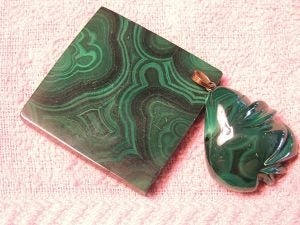Personal Effects, Feb. 24
Published 1:22 am Saturday, February 24, 2018
BY JERRY SAMPSON
Question: Dear Mr. Sampson, I enjoy your articles so much that I wanted to contact you about something. My brother-in-law passed away several years ago and left a lot of stones. He was always collecting gems and rocks. He kept little cases of them in his study. Most were marked but not these.
There are about six little pieces, I’ve shown you two of them. My son thinks that it’s a green marble and the rest of them are a type of agate. The green color is intense and has all of these rings like tree rings.
What is it and does it have any value? The free form one has a hanger for a pendant. Thanks.
 Answer: One of my favorite stones! I was just talking about this stone with a friend at my book club last week. You have a small collection of malachite. Malachite is a copper carbonate hydroxide mineral that comes in several forms. The most desirable is the stalagmitic masses. That means that it forms like a stalactite like you’d see in a cave, but underground.
Answer: One of my favorite stones! I was just talking about this stone with a friend at my book club last week. You have a small collection of malachite. Malachite is a copper carbonate hydroxide mineral that comes in several forms. The most desirable is the stalagmitic masses. That means that it forms like a stalactite like you’d see in a cave, but underground.
Your comparison to tree rings is very correct, as that is how it grows. It’s deep in fractures and spaces in the ground that the stone interacts with the water table, other minerals and fluids to create that stunning color.
Malachite can be found all over the world — all the way from Britain to Zambia, New South Wales, France and the Southwestern U.S.A. especially Arizona. However, its largest and most important mines are in the Urial Mountains in Russia. The Russians have so much of it that in the past they have veneered walls with it and created massive columns, urns and vases out of it. The Hermitage in St. Petersburg has many fine examples.
The name malachite, in part, comes from Middle English, melochites, meaning mallow green stone,due to its resemblance to the plants green leaves. The Egyptians, who also mined this stone, thought the color of the stone represented death and the power of resurrection, as well as new life and fertility. Greeks and Romans ground it to use as eye shadow. And in the Middle Ages it was thought to protect children and ward off witches.
Inferior malachite has been used as a paint pigment from the time of ancient times until 1800, when it was replaced by synthetic pigments. Of course, malachite has been used as jewelry for thousands of years and I see why.
That color is rich and deep and one of the most beautiful in the world. Malachiteis a soft stone so it was fairly easy to carved and turn. By the way, malachite is ALWAYS green. The pieces you have are lovely but have little value. Each piece at a lapidary show might be priced at $20 each. Wear the pendant and display the square piece. They are too, too pretty to keep locked up. Thanks for sharing it.





